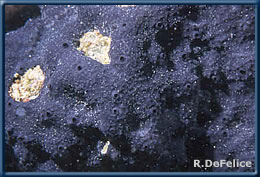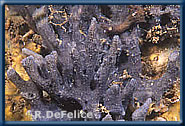

Haliclona caerulea

Gelliodes fibrosa

Suberites zeteki

Zygomycale parishii

Mycale armata
Gelliodes fibrosa
 Gray
encrusting sponge
Gray
encrusting sponge
Phylum Porifera
Class Demospongiae
Order Haplosclerida
Family Niphatidae
Description
Growth Form
Most commonly occurring morphology is a thickly encrusting mat with anastomosing
and meandering branches, some branches may be erect.
Color
Exterior color is blue-gray, interior grayish beige.
Texture and Surface Features
 Spongy,
fibrous, elastic, tough. Surface is variable, smooth to irregularly conulose,
with protruding tufts of fibers.
Spongy,
fibrous, elastic, tough. Surface is variable, smooth to irregularly conulose,
with protruding tufts of fibers.
Spicules
Megascleres: curved oxeas (160-180 mm) Microscleres: small sigmas (15
mm)
Habitat
In the Hawaiian Islands, G. fibrosa is mainly
restricted to shallow-water fouling communities (i.e. pier pilings, floating
docks) of the major harbors or associated disturbed habitats (i.e. dredged
channels and artificial lagoons) on Oahu, Kauai and Maui. In Kaneohe Bay,
G. fibrosa is found on patch reefs in southeast
corner of the Bay as well as the fouling  community
on Coconut Island floating docks. On patch reefs, it is typically found
encrusting the shaded underside of plate corals.
community
on Coconut Island floating docks. On patch reefs, it is typically found
encrusting the shaded underside of plate corals.
Distribution
Hawaiian Islands
Oahu - leeward coast harbors, and Kaneohe Bay
Maui - Kahului Harbor
Kauai - Nawiliwili Harbor
Native Range
Philippines
Present Distribution
Philippines, main Hawaiian Islands, and possibly Guam
Mechanism of introduction
Unintentional introduction, as fouling on ships' hulls
Impact
Fouling organism. Ecological impact unstudied, but observations suggest
competition for space with native invertebrates. Possible threat to corals
in protected habitats, such as Kaneohe Bay.
Ecology
Feeding
Sponges are filter feeders, continuously circulating water through their
bodies. Microscopic food particles are removed from water by specialized
collar cells. Digestion is intracellular (phagocytosis and pinocytosis).
Reproduction
Like most sponges, G. fibrosa is probably
capable of asexual reproduction by fragmentation of the adult. Details
regarding sexual reproduction of this species are unknown. (See Reproduction
of Sigmadocia caerulea for general description
of sponge reproduction.)
Remarks
Although the holotype remains to be examined, spiculation and skeletal
details of the Hawaiian specimens agree well with Gelliodes
fibrosa (Wilson 1925) first described from the Philippines and
then later by de Laubenfels (1935). This species is not recorded elsewhere
to date in the Indo-Pacific except the Philippines. This sponge was found
to be abundant in 1997 on hull of a floating dry-dock in Pearl Harbor,
Oahu brought from the Philippines in 1992. G. fibrosa
was also recently transported to Guam (1999) on the hull of the very same
dry-dock, but it's current population status there is unknown.
We consider this abundant and conspicuous species to be nonindigenous
and it's presence in the Hawaiian Islands to be the result of a recent
unintentional introduction, probably as fouling on the hull of a ship
or floating dry-dock. It currently occurs in areas that have been extensively
surveyed by sponge experts de Laubenfels (1940s and 50s) and Bergquist
(1960s), and could not have been overlooked. It has become established
in Pearl and Honolulu Harbors and Kaneohe Bay (Oahu), Kahului Harbor (Maui),
and Nawiliwili Harbors (Kauai). It was not yet present in harbors on the
island of Hawaii when surveys were conducted there in 1996.
References
De Laubenfels, M.W. 1935. A collection of sponges from Puerto Galera,
Mindoro, Philippine Islands. Phil. J. Sci. 156(3):327-336.
© 2002 Hawaii Biological Survey, Bishop Museum
contact